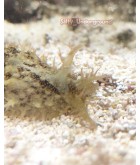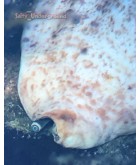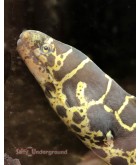Flatworms are a pest that can be removed from the reef aquarium. There are several types of flatworms in the marine aquarium but they can all be killed or removed the same way. Some saltwater fish like wrasses are known to eat flatworms as are others that are know to pick at live rock may also work in eating the flatworms.
Some flatworms live on live coral like mushrooms, leathers, elegance corals and some other. They can become so thick that if not taken care of that they will block the light to the coral and smoother it.
When flatworms first start taking up residence on a live coral, they can look like a coral with very small dark spots on it and then those spots just keep growing. These spots on the coral can also be a light white color to almost clear.
Some methods used to remove flatworms:
If possible try and increase the flow in low flow areas where you see flatworms collect on the aquarium or live rock. Flatworms don't like high water flow.
You should do a water change to bring the water quality up and the nutrients down in the aquarium. Some kinds flatworms can be worse in aquariums with high nutrients.
With the flatworms that live on the coral, take the coral out of the aquarium and rinse it off in a bucket of saltwater. You can also rinse and dip the coral in salifert flatworm exit. Although some soft corals do not handle being dipped in flatworm exit very well.
If you can't get the corals out of the aquarium or the whole aquarium is infested, then you can use Salifert Flatworm Exit on the whole reef aquarium. Flatworm Exit can be hard on some life in the aquarium like red worm rock and anything like that should be taken out before starting. Follow the directions for the Flat Worm exit closely and be cautious. You can have had good results with Flatworm Exit but on occasion you may have to dose the aquarium again a few days later to kill them all. It is best to follow the directions.
Another way to kill flatworms is with Intercepter.
This will take at least 6 hours. It is recommended to use a minimum of 3 treatments, 1 week apart. Use 25mg per 10 gallons of aquarium water. Make sure to account for water displacement from your rocks and substrate. Include the water in your sump and plumbing. Each tablet, when ground, treats 380 gallons. Grind the tablets to a fine power, preferably using a mortar and pestle. When possible, use a scale that measures to 0.001 grams to ensure accuracy. Measure out the powder onto the scale, and be as accurate as possible. Remember, it is just 25mg per 10 gallons of water.
Turn off your skimmer, ozone generators, UV sterilzers, and any mechanical filtration. Remove any carbon. Your pump stays on, as you still want water to circulate into your sump/refugium . You also want to treat the water inside your calcium reactor and skimmer (while the skimmer is off).
Remove any invertebrates you want to save, like shrimp and crabs. It is slightly possible they will be infested as well.
Dissolve the pre-measured powder into some aquarium water, stirring frequently. Once it is dissolved, spread the mixture on top of the water.
Wait 6 hours! You aquarium water should look normal during the whole treatment. If anything looks like it is going wrong during the treatment, immediately do a water change and add activated carbon.
After the 6 hours is up, do at least a 25% water change and add activated carbon. It should be safe to reintroduce your invertebrates after the water change.
Do another 25% water change 24 hours later and replace the activated carbon.




